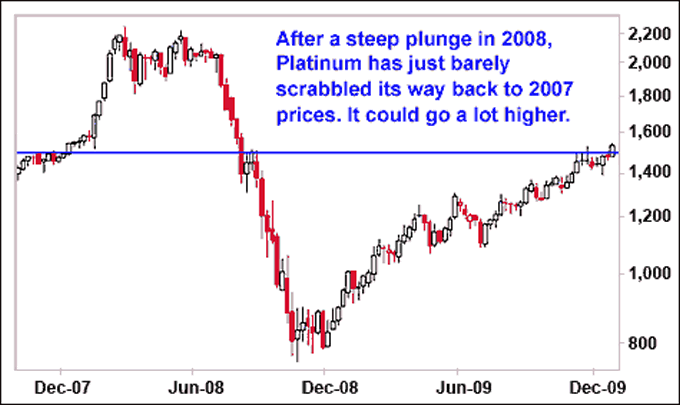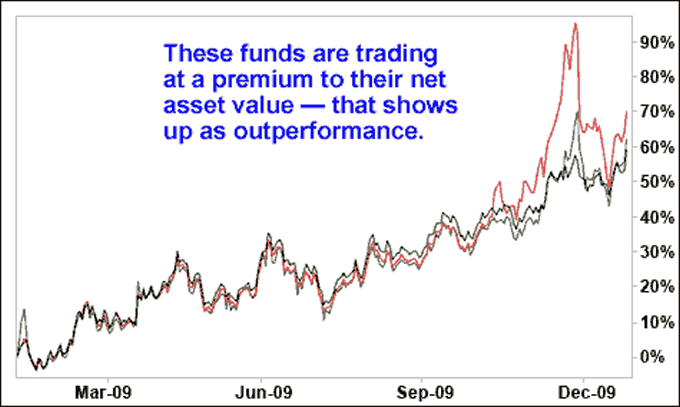Platinum in the Fast Lane
Commodities / Platinum Jan 08, 2010 - 08:27 AM GMTBy: Sean_Brodrick
 Many investors know their way around gold or crude oil, but not a lot know what they need to know about platinum. And that’s too bad, because it’s becoming easier than ever to invest in platinum, with a third platinum exchange-traded fund about to make its debut in the U.S. That doesn’t mean you should rush out and buy it — there are some pros and cons to this metal, with potential for rich rewards and equally big losses for the unwary.
Many investors know their way around gold or crude oil, but not a lot know what they need to know about platinum. And that’s too bad, because it’s becoming easier than ever to invest in platinum, with a third platinum exchange-traded fund about to make its debut in the U.S. That doesn’t mean you should rush out and buy it — there are some pros and cons to this metal, with potential for rich rewards and equally big losses for the unwary.
I’ll tell you about the platinum funds. First, some platinum facts …
- All of the platinum ever mined would fill a room measuring less than 25 feet on each side. Moreover, above ground supply of platinum could be expected to last about a year, compared to about 25 years for gold.
- The largest known reserves of platinum are found in South Africa, with Russia and Canada also having some of the larger platinum deposits. South Africa accounts for approximately 80% of the world’s platinum supply. Only about six million ounces of platinum are produced by mines every year. That amounts to less than 5% of annual gold production. Platinum is rare.
- Like gold and silver, platinum can be used for jewelry. But jewelry demand is now only 20% of yearly platinum demand versus 40% just five years ago. And even if you don’t own platinum jewelry, you may be using this dense, malleable, corrosion-resistant metal every day. That’s because the biggest and growing demand for platinum is in industrial products, especially in catalytic converters for automobiles.
- Since more than half the world’s platinum is used in catalytic converters, platinum sees its price rise and fall with demand for new automobiles. When the U.S. auto industry took it on the chin, platinum prices plunged. They’ve since recovered, but are still off their highs.
Now here’s the interesting thing about platinum demand. Global auto sales are coming out of their slump and shifting into higher gear. You saw that Ford’s sales grew 25% in December. But China’s auto sales have passed that of the U.S., and should grow by 44% year over year to 13.5 million vehicles.
Want some more fascinating facts? There are about 900 cars for every 1,000 people in the U.S. But there are only 30 cars per 1,000 people in India, and less than 10 cars per 1,000 people in China. Where do you think car sales will go in India and China? I’d say zoom-zoom! And what will that do to platinum demand for catalytic converters? Zoom-zoom again!
Result: Metals experts at Johnson Matthey expected the platinum market to have a small annual surplus of 140,000 ounces in 2009, but that surplus could go away in 2010.
Where would that take the price of platinum? HSBC has a target of $1,600 an ounce, and my target is $1,700. That’s an 11% move from recent levels.
 |
But it could go higher, perhaps back to its 2008 high around $2,300 an ounce, especially since it’s such a thin market. There isn’t a lot of platinum around. Once the bulls — or the bears — get running, they’re hard to stop.
So the outlook for platinum is pretty darned bullish. And that brings us to the platinum funds …
The iPath Dow Jones-UBS Platinum Trust Subindex TR ETN (PGM) is based on an index composed of one futures contract on platinum. It has an expense ratio of 0.75%, and an average daily volume of 66,000 shares. It has a market cap of $137.77 million, and it recently traded at a 9.25% premium to its net asset value.
The E-TRACS UBS Long Platinum ETN (PTM) is based on a basket of platinum futures contracts. It has an expense ratio of 0.65%, and an average daily volume of 61,000 shares. It has a market cap of $84.3 million, and recently traded at a 4.28% premium to its net asset value.
Do you see what these two funds have in common? Neither of them holds physical platinum. That’s not necessarily bad, but if you like your fund to hold the physical metal, be aware of that. Also, both funds have stopped creation of new shares (for now), so they trade at a premium.
Let’s look at one-year performance charts of PGM, PTM and platinum …
 |
PGM is leading the pack, but that outperformance could go away quickly if it starts issuing new shares and its premium evaporates. It also charges a higher expense ratio.
UBS also offers the E-TRACS CMCI Short Platinum Excess Return ETN (PTD), a product that tracks the inverse of a basket of platinum futures contracts plus a fixed income return on a Treasury Bill Portfolio. So, if you’re bearish on platinum, PTD is the fund for you.
Anyway, now we are going to have a NEW platinum fund to play with. ETF Securities has filed for approval for physically backed platinum and palladium ETFs in the U.S. So unlike the other two funds, which don’t have an effect on the physical market, this new platinum fund (symbol PPLT) will hold the actual metal.
ETF Securities has enjoyed quite a bit of success with two other funds it’s launched in the U.S. recently — the ETFS Physical Swiss Gold Shares (SGOL) and the ETFS Silver Trust (SIVR). Together, they have racked up about $465 million in total assets.
Let’s say the new platinum fund gets half as much. That would take about 148,720 ounces of platinum off the market at current prices. But it probably won’t be current prices, because we’ve seen what happened to the gold ETFs — they’ve become a market mover, because metal is taken off the market and put in storage to back the ETFs. SPDR Gold Shares (GLD), the world’s largest gold ETF, holds more gold than all but four of the world’s central banks and the International Monetary Fund, according data compiled by the World Gold Council.
Why would investors choose PPLT over PGM or PTM? Well, along with the fact that it will hold the physical metal, ETF Securities has wrestled market share from larger funds in part because of its lower cost structure. SGOL has an expense ratio of 0.39%, which is slightly under the 0.40% charged by the GLD, and SIVR charges 0.30% compared to 0.50% for SLV.
So if a new fund starts buying physical metal in a very small market, yes, I think platinum could blast off.
And that’s not the only new source of demand. Let’s get back to China for a minute. There are 1.3 billion new consumers in that country, and they have an affinity for precious metals. China’s demand for platinum jewelry was expected to double in 2009, and that trend should continue as long as prices remain below their peaks.
In short, the outlook for platinum is very bullish. But before you buy, go back and look at that first chart I showed you. You can see a 65% drop in platinum from peak to trough in 2008. Ouch! A volatile, thin market can work both for and against you. I would only recommend buying on dips — and set your price target to sell on the rips.
Yours for trading profits,
Sean
P.S. Be sure to check out my new book, The Ultimate Suburban Survivalist Guide. It’s on sale at Amazon.com right now!
This investment news is brought to you by Uncommon Wisdom. Uncommon Wisdom is a free daily investment newsletter from Weiss Research analysts offering the latest investing news and financial insights for the stock market, precious metals, natural resources, Asian and South American markets. From time to time, the authors of Uncommon Wisdom also cover other topics they feel can contribute to making you healthy, wealthy and wise. To view archives or subscribe, visit http://www.uncommonwisdomdaily.com.
© 2005-2022 http://www.MarketOracle.co.uk - The Market Oracle is a FREE Daily Financial Markets Analysis & Forecasting online publication.



